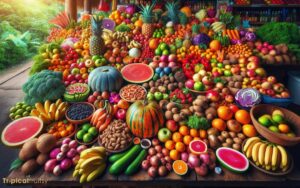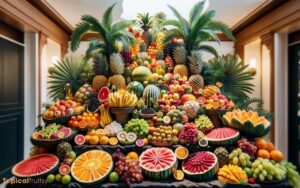How to Grow Tropical Fruits? 7 Easy Steps!
Successfully growing tropical fruits requires careful consideration of climate compatibility, soil conditions, propagation techniques, and ongoing care including watering, fertilization, and pest control.
Appropriate harvest and storage practices are also critical to ensuring fruit quality.
When growing tropical fruits, the following factors are essential:
For example, growing mangoes requires a frost-free climate, while pineapples need acidic soil. Master the art of nurturing tropical fruits with tailored care for bountiful, flavorful harvests.
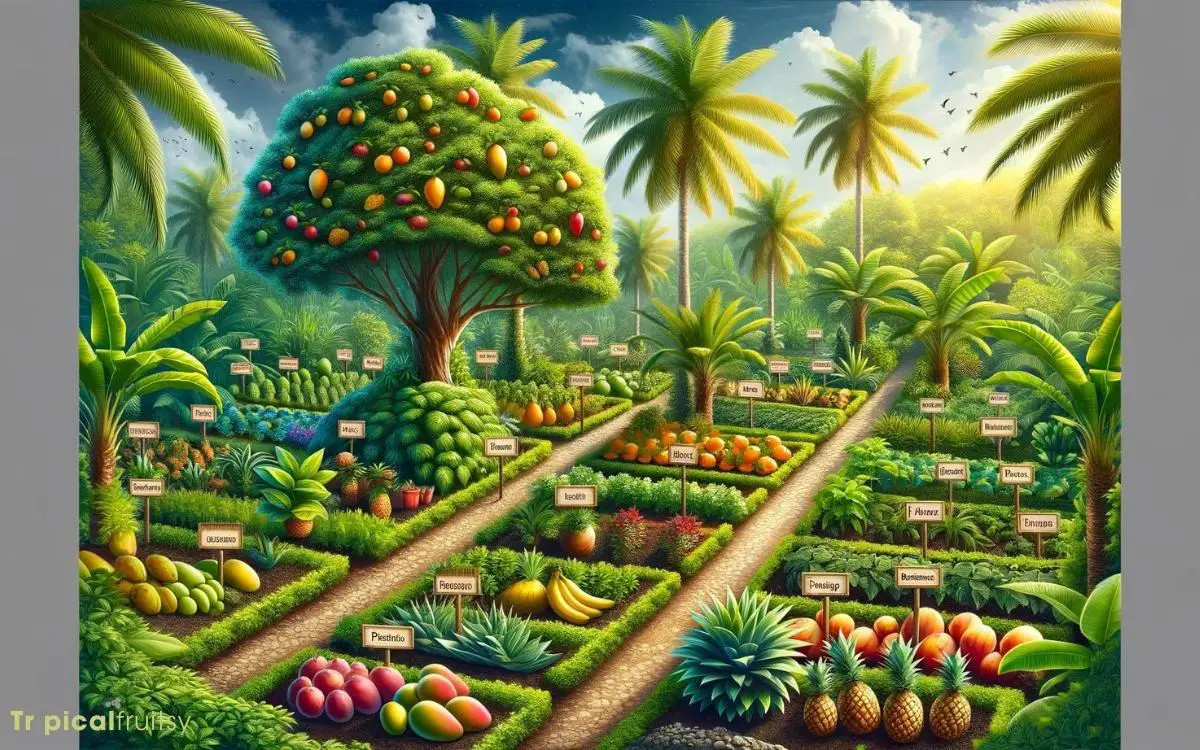
Key Takeaway
It’s important to provide consistent moisture, control humidity levels, and adapt watering schedules to the climate conditions.
7 Steps: To Grow Tropical Fruits
| Step | Description | Example |
|---|---|---|
| Climate Assessment | Ensure the local climate is suitable for the fruit type. | Mangoes need a frost-free environment. |
| Soil Preparation | Achieve correct nutrient balance, drainage, and pH level. | Pineapples thrive in acidic soil. |
| Propagation | Choose the right method like seeding or grafting. | Papaya is commonly grown from seeds. |
| Watering & Humidity | Provide consistent moisture and control the humidity. | Bananas require high humidity. |
| Fertilization | Feed plants with appropriate fertilizers regularly. | Citrus fruits benefit from nitrogen-rich fertilizers. |
| Pest/Disease Control | Implement measures to prevent and treat plant health issues. | Use neem oil for organic pest control. |
| Harvesting & Storage | Harvest at the right time and store under proper conditions. | Avocados ripen off the tree and need cool storage. |
Choosing the Right Fruits
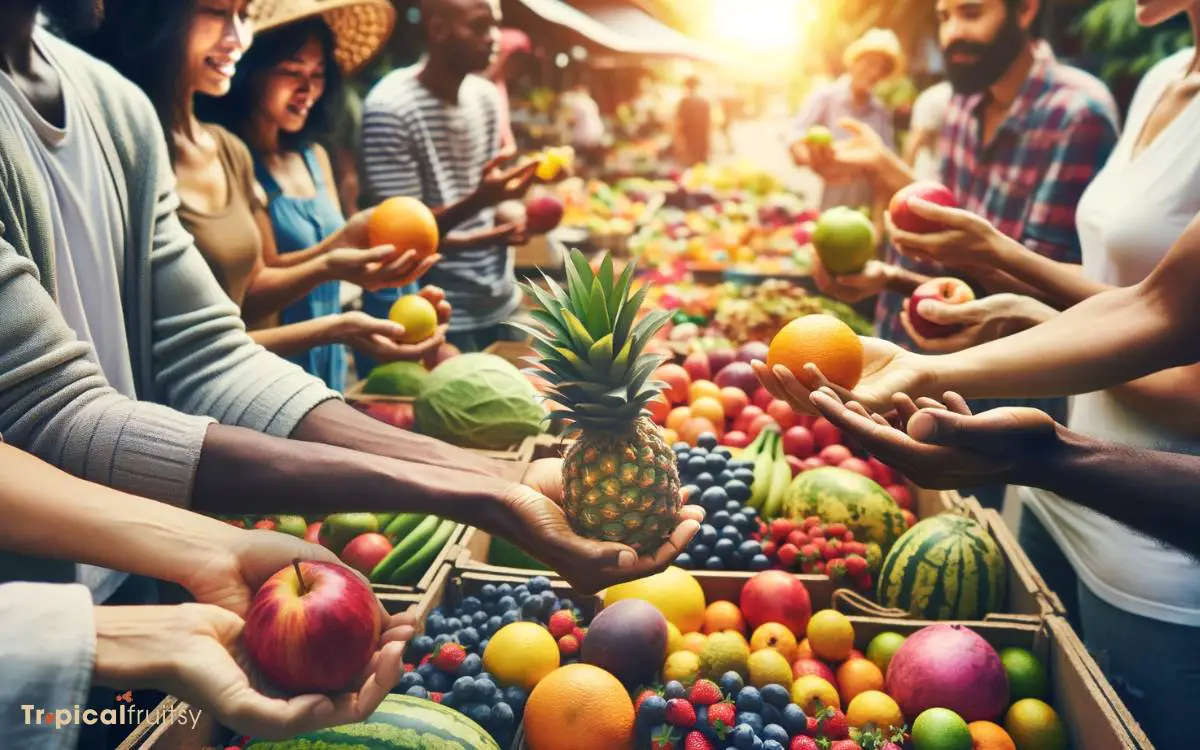
Selecting the appropriate tropical fruits for cultivation is often contingent upon the specific climatic conditions and soil types of your region. Tropical fruits typically require a warm and humid climate with minimal frost exposure.
The viability of species such as Mangifera indica (mango) and Ananas comosus (pineapple) is largely dependent on these climatic requisites.
Soil properties such as pH level, drainage, and fertility are also critical factors. For example, Carica papaya (papaya) thrives in slightly acidic to neutral soil, whereas Citrus spp. (citrus fruits) demand well-drained, loamy soils.
Integrating these agronomic variables with research on local environmental constraints and pest and disease prevalence is imperative for optimizing fruit selection.
This strategic approach ensures the sustainability and economic viability of tropical fruit cultivation endeavors.
Understanding Climate Needs

Throughout the year, tropical fruit cultivation requires consistently warm temperatures and high humidity levels to ensure successful growth and fruiting.
Optimal conditions typically include temperatures ranging from 20°C to 30°C (68°F to 86°F) and humidity levels above 50%.
These parameters are crucial as they directly impact physiological processes like photosynthesis, respiration, and transpiration.
Moreover, tropical fruits demand a frost-free environment, with many species sensitive to cold snaps which can devastate crops and inhibit proper development.
Understanding microclimates is essential, as variations in elevation and proximity to bodies of water can significantly influence local climates.
Growers must engage in meticulous weather monitoring and employ protective measures such as greenhouse cultivation or shade cloths to mitigate unfavorable conditions.
Precise knowledge of a species’ climate requirements is indispensable for selecting appropriate cultivars for a given region.
Soil Preparation Techniques
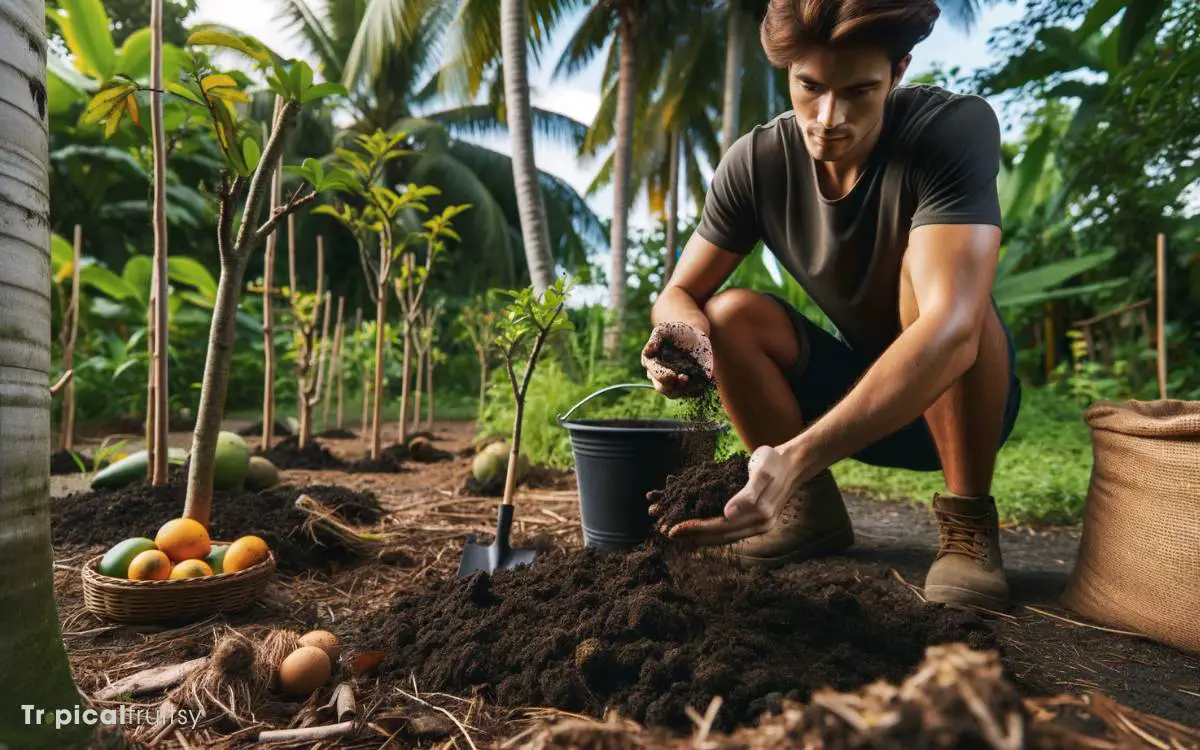
Successful cultivation of tropical fruits necessitates precise soil preparation, with attention to achieving optimal pH levels critical for nutrient uptake and plant health.
Incorporation of organic matter into the soil profile not only improves soil structure but also enhances water retention and microbial activity, which are essential for robust fruit development.
These preparatory steps, underpinned by agronomic research, lay the foundation for a fertile growing environment conducive to tropical fruit production.
Optimal Ph Levels
Soil pH plays a crucial role in the cultivation of tropical fruits. Most species thrive in slightly acidic conditions, typically ranging from 5.5 to 6.5.
Achieving this pH balance is essential for nutrient uptake. It influences the solubility and availability of elements like nitrogen, phosphorus, and potassium, which are critical for the growth and fruiting of tropical species.
Precise soil testing should be conducted before planting to establish baseline soil pH levels. If adjustments are necessary, elemental sulfur can lower pH, while lime can raise it.
These amendments should be incorporated into the soil well in advance of planting to allow for proper chemical interactions and stabilization.
With optimal pH levels established, the next step involves the integration of organic matter to enhance soil structure and fertility.
Organic Matter Integration
Integrating substantial amounts of organic matter into the soil is a pivotal step in preparing for the cultivation of tropical fruits, as it significantly improves soil structure and enhances nutrient availability.
The introduction of organic material fosters microbial activity, which in turn assists in nutrient cycling and improves water retention capabilities.
For growers committed to maximizing the potential of their tropical fruit crops, consider the following soil preparation techniques:
- Composting: Regularly incorporate well-decomposed compost to enrich the soil with essential nutrients.
- Green Manuring: Utilize cover crops to add nitrogen and organic content when turned into the soil.
- Mulching: Apply organic mulch to conserve moisture, suppress weeds, and gradually improve soil fertility.
- Vermicomposting: Introduce earthworms to expedite decomposition and enhance soil aeration and nutrient profile.
Planting and Propagation
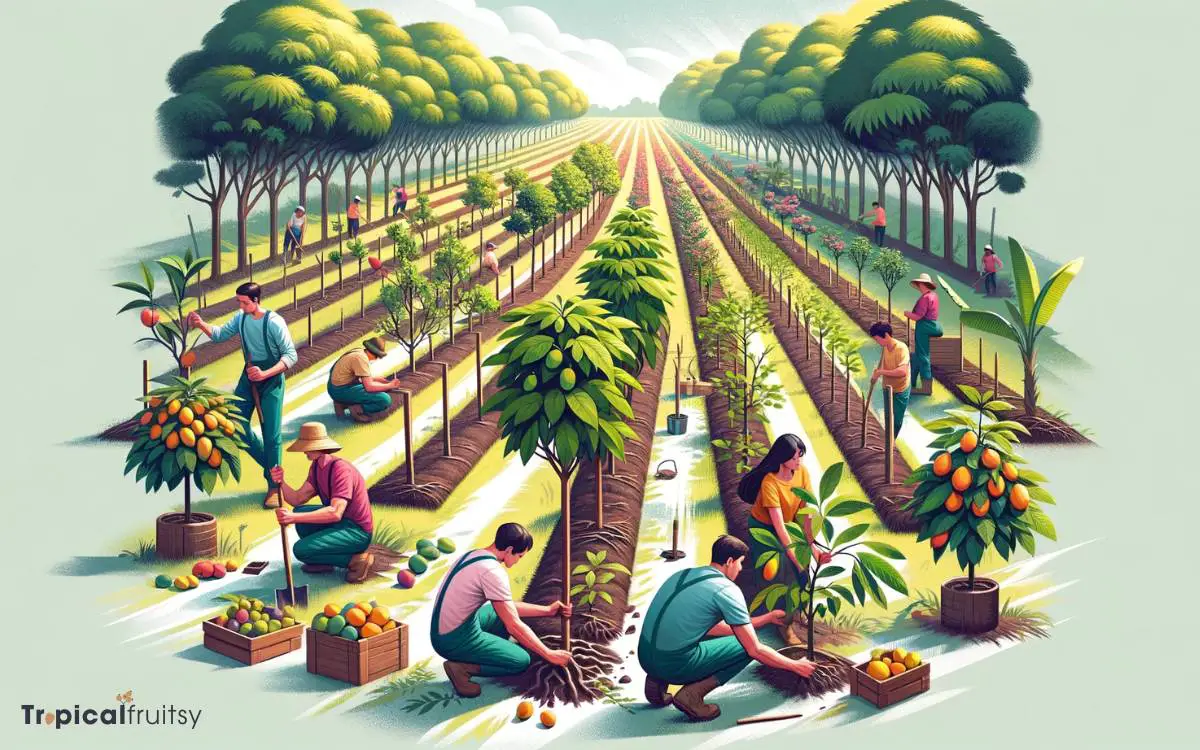
While various tropical fruits have unique requirements, the general process of planting and propagation typically begins with selecting high-quality seeds or healthy cuttings from mature plants.
Ensuring genetic fidelity and optimal growth potential, the chosen propagules must be prepared and treated according to species-specific protocols to enhance germination or rooting success.
| Fruit Type | Propagation Method | Key Considerations |
|---|---|---|
| Mango | Seed/grafting | Polyembryonic seeds preferred |
| Papaya | Seed | Fast-germinating, light-sensitive |
| Pineapple | Crown cuttings | Requires removal of lower leaves |
| Avocado | Seed/grafting | Seed viability diminishes quickly |
| Dragon Fruit | Stem cuttings | Requires well-drained soil |
Propagation mediums should be sterile and nutrient-rich to support initial growth phases.
Environmental factors such as humidity, temperature, and light intensity must be carefully controlled to mimic tropical conditions, fostering successful plant establishment.
Watering and Humidity Control
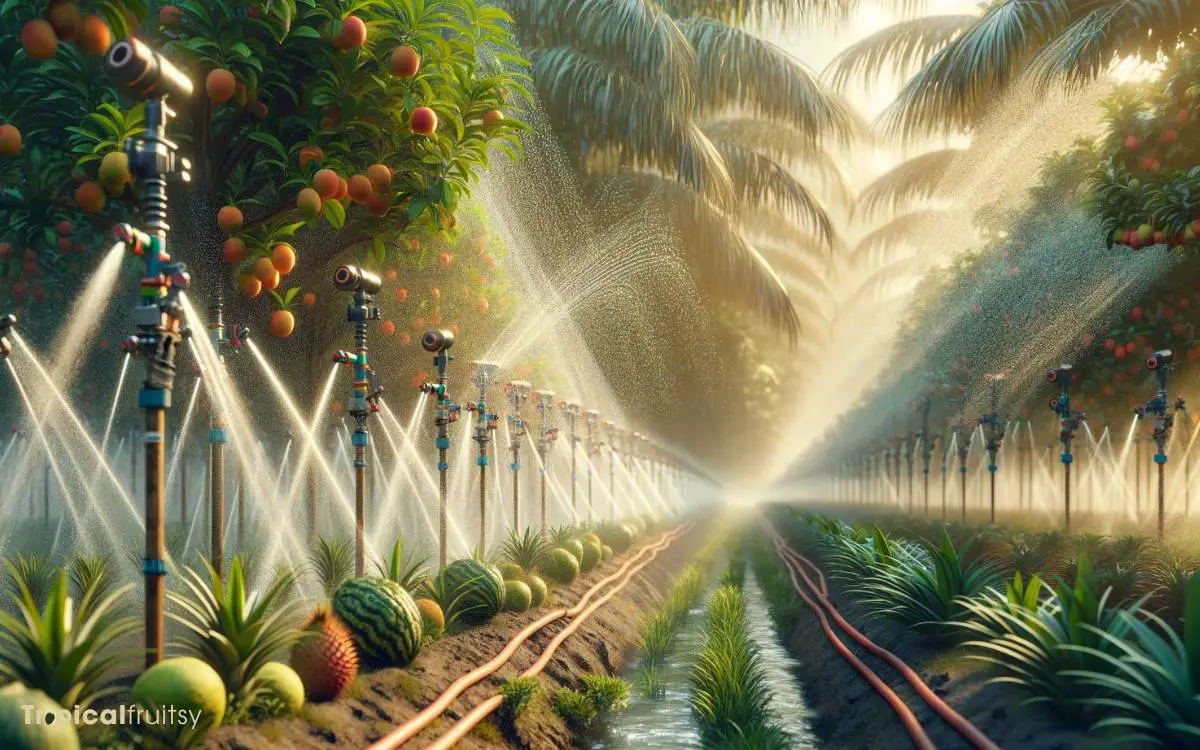
Watering and humidity are pivotal factors in the successful cultivation of tropical fruits. They require precise management to mimic their native environments.
Optimal watering schedules vary by species. However, they generally entail consistent moisture levels that avoid both waterlogging and drought stress.
To maintain ideal humidity, which often ranges from 70-90% for many tropical fruit plants, growers must employ strategies such as misting systems or humidifiers. This is particularly important in controlled environments like greenhouses.
Optimal Watering Schedules
One must carefully regulate water and humidity levels to meet the specific needs of each tropical fruit species for successful cultivation.
The following key factors should be meticulously observed:
- Species-Specific Requirements: Different tropical fruits demand varying water quantities. For example, lychee trees require more water during fruit set and less during other times.
- Soil Moisture Monitoring: Utilize tools such as soil moisture sensors or tensiometers to gauge the precise water needs and avoid over or under-watering.
- Climate Adaptation: Tailor watering schedules to the local climate, factoring in rainfall patterns and evaporation rates to optimize irrigation.
- Humidity Management: In areas with low humidity, consider using misting systems to maintain the necessary microclimate around the plants.
Maintaining Ideal Humidity
To ensure the vigorous growth of tropical fruits, it is crucial to keep a close eye on the ambient humidity levels within their growing environment.
Tropical fruit plants typically thrive in environments with high humidity, often between 70% and 90%. To achieve this, growers can utilize misting systems that periodically release fine sprays of water, increasing moisture levels in the air.
Additionally, maintaining a layer of mulch around the plants helps to retain soil moisture and regulate the microclimate.
In indoor settings, humidifiers can be an effective tool, while in greenhouses, automated climate control systems monitor and adjust humidity levels precisely.
Data loggers and hygrometers are indispensable for providing accurate measurements, enabling growers to maintain optimal conditions.
As the balance of water and air sets the foundation for growth, it becomes equally important to address the nutritional needs of tropical fruits through targeted fertilizing and nutrient management strategies.
Fertilizing and Nutrient Management
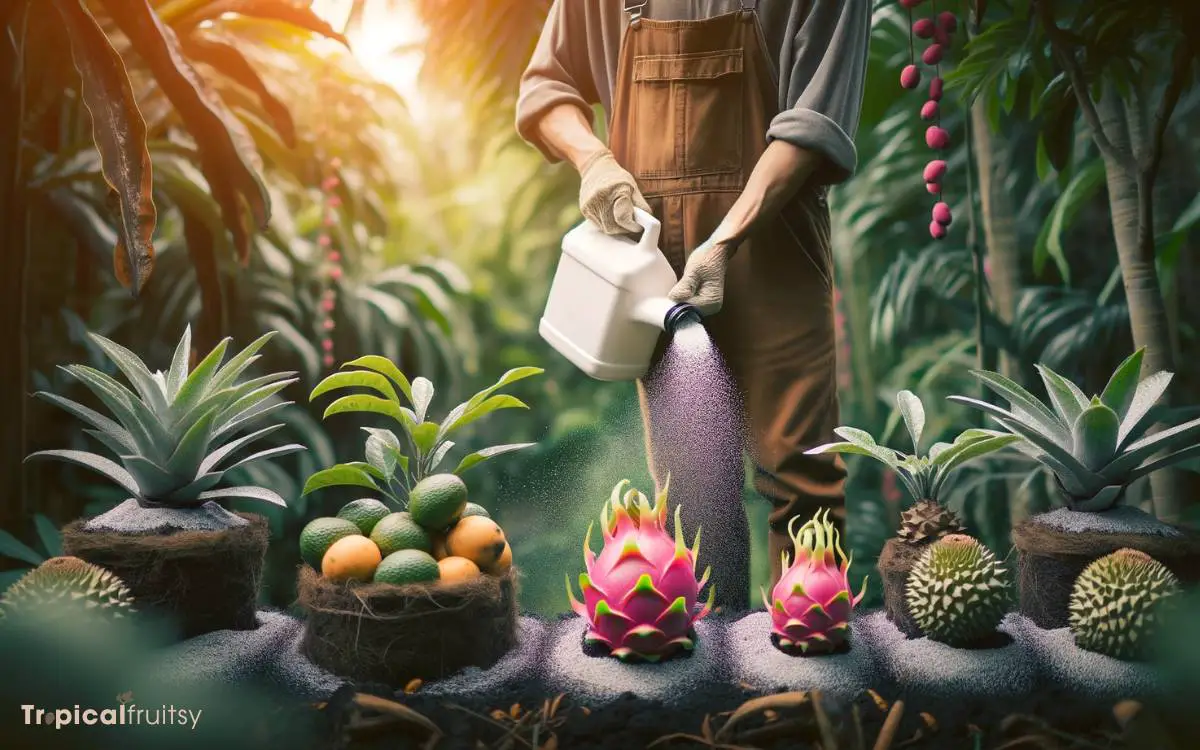
Implementing a comprehensive fertilizing and nutrient management strategy is essential for the health and productivity of tropical fruit plants.
To ensure optimal growth and fruit production, a detailed understanding of soil nutrient content and plant requirements is required.
Here are key considerations:
- Soil Testing: Regularly analyze soil to determine nutrient levels and pH balance, tailoring fertilizer composition and application rates accordingly.
- Appropriate Fertilizer Selection: Choose fertilizers with the correct N-P-K (Nitrogen-Phosphorus-Potassium) ratios and micronutrients like magnesium, calcium, and sulfur based on the plant’s specific needs.
- Application Timing: Apply fertilizers at critical growth stages such as flowering and fruit set to maximize nutrient uptake.
- Monitoring and Adjusting: Continuously monitor plant health and soil conditions, adjusting fertilization practices to prevent nutrient deficiencies or toxicities.
Pest and Disease Prevention
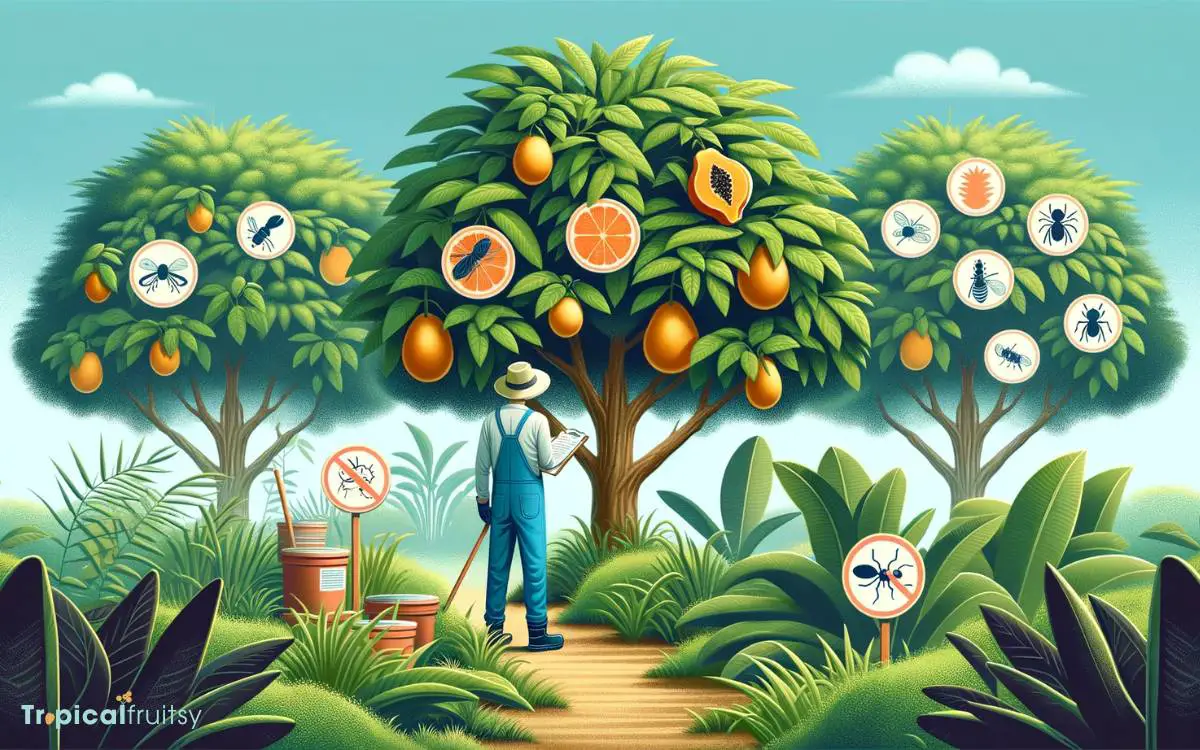
Effective pest and disease management is crucial for maintaining the health and yield of tropical fruit crops.
A comprehensive approach involves regular monitoring for early detection and identification of pathogens and pests.
Implementing integrated pest management (IPM) strategies that combine biological controls, such as beneficial insects, with cultural practices, like crop rotation and sanitation, can effectively minimize infestations and infections.
Additionally, resistant varieties should be selected when available, and precise application of approved pesticides or fungicides may be necessary when pest or disease pressure exceeds actionable thresholds.
Thoroughly documenting pest occurrences and treatment efficacy aids in refining prevention plans.
It is essential for growers to stay informed about emerging threats and evolving management techniques through continuous education and collaboration with agricultural extension services.
Can I Use the Tropical Fruits I Grow to Make Juice?
Yes, you can use the tropical fruits you grow to make delicious and refreshing tropical fruit juice. There are numerous tropical fruit juice recipes available that use a variety of fruits like mango, pineapple, and passion fruit to create a tasty and nutritious beverage.
Harvesting and Storage Tips
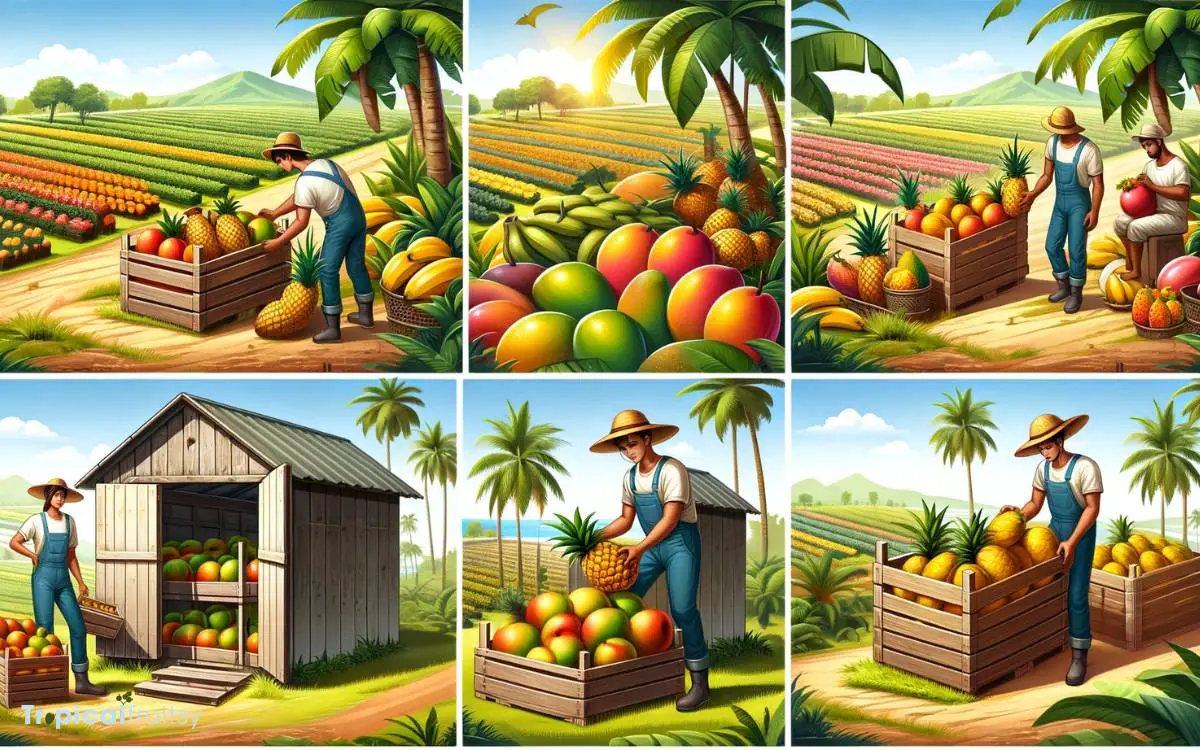
Harvesting tropical fruits at the optimal stage of ripeness is essential for maximizing both their flavor and shelf life, following diligent pest and disease management practices.
To ensure the best results, consider the following strategic approaches:
- Identify Ripeness Cues: Learn the specific color, firmness, and aroma cues for each fruit type to determine the perfect harvest time.
- Implement Gentle Handling: Use careful techniques to avoid bruising, which can lead to premature spoilage.
- Regulate Storage Conditions: Store fruits at appropriate temperatures and humidity levels to slow down ripening and decay processes.
- Monitor Regularly: Inspect stored fruits regularly for signs of deterioration or infestation to remove affected items and prevent spread.
Adhering strictly to these guidelines will help ensure that your tropical fruits retain their peak quality from tree to table.
Conclusion
Successful cultivation of tropical fruits requires meticulous attention to climate, soil conditions, and plant care.
By implementing proper techniques in planting, watering, fertilizing, and pest management, growers can optimize fruit yield and quality.
An interesting statistic to note is that over 70% of the world’s pineapples are now grown in tropical Asia, reflecting the region’s adoption of effective tropical fruit agriculture practices.
Continued research and adaptation are vital to sustain and improve tropical fruit production in varying environments.



